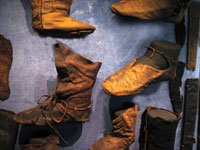Viking Clothing - What did the Vikings Wear?
Viking clothing had styles of their own. The social class differences between people inVikings Age society are very evident in the clothing they wore. From the style and cut of the outfit, the materials used and quality of the clothes pins which held it in place, is a clear indication of the owner's wealth and status within their community. This holds true for both men and women.
 Typical Viking Female Clothing |
Clothing pins which were made of metal have been found in large numbers of Viking Age graves and settlements. The clothing material the used has proved to be much harder to find. The textiles used simply haven’t managed to survive the ravages of time. We have learned a little about the materials used in making Viking Age clothing from small fragments of material which have been found.
The best evidence about the materials the Vikings used comes from some bundles of discarded fabric which were found preserved in the mud in Hedeby port. The materials appear to have been used as packing material or perhaps in connection with the tarring of ships. This find represent a rare source of information on the different types and qualities of the materials used during the Viking Age. It has also shed light on the tailoring methods used.
Fashion changed very slowly during this period. So, we can be fairly sure that the dressing styles which have been reconstructed based on findings are a fairly good representative of Viking dressing styles as a whole.
Depictions of men and women on various artefacts indicate that long hair was favoured by both sexes. Some men shaved their hair or had it rolled in a tight bun near the nape of the neck. While some women organized their long, billowing hair into a quite complicated series of knots on the crown of the head.
The sheer amount of combs which have been found in excavated sites suggest that the Viking people were highly concerned about their hair. Combs of course could help control head lice, but it is obvious that hair style was very important to the Vikings.
Men would have finely groomed beards and moustaches. Men's attire consisted of trousers and a long tunic which was topped with a cloak. The outfit was held in place by a single brooch.
The women wore multiple layers of ankle length clothing. They would be made of both wool and linen. The women's clothing would be held in place by a pair of brooches, one on each shoulder. These brooches were usually oval shaped, although the styles varied from region to region. Women would often have a third brooch which would sit near the neck.
 Viking Age Leather Shoes |
Viking shoes were essentially made of a large piece of leather, which was sewn into the shape of the users foot. The shoes were usually secured with leather straps. There does not appear to have been much difference in shoe styles between the sexes. Shoes appear to have been primarily about function rather than style. Individuals with the financial means would have worn course heavy woolen socks to keep warm, while those who could not afford such a luxury likely stuffed their shoes with dried grass or moss.
Viking clothing was an important symbol of status during the Viking Age, much like it is today. While the styles and fabrics certainly may not represent high fashion in todays society, you can be certain that diplaying ones wealth through fashion was as important then as it is today.
LastUpdate: 2019-06-26 19:08:21
